A New Star– the Spessartine Garnets
January 30th, 2010 by James L. Sweaney, CGA, FGA. GG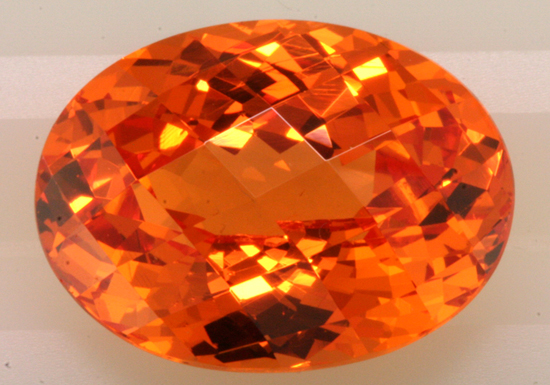
11.56 ct. Gem Spessartine Garnet
As we mentioned in our recent blog, we're always excited to see the latest gem finds displayed at the upcoming Tucson gem shows. In recent decades Africa has been the biggest producer of wonderful new gemstones and gem materials.
The heavily mineralized Great Rift valley along the eastern side of the continent was one of the areas intensively prospected in the last half of the 20th century, resulting in such spectacular gem finds as the famous discovery of tanzanite deposits in the Merelani region of Tanzania and the wonderful green garnet, aptly named Tsavorite by its discoverer, Campbell Bridges, for the famous Tsavo game park of southern Kenya. Numerous sapphire, ruby, emerald, and alexandrite finds, along with many other less commercially important gems were also uncovered along the Rift region during this period
More recent finds in the western half of Africa have included the wonderful spessartine garnets of Namibia and Nigeria. These gems occur in a wonderful array of reds, red oranges, and oranges.
The first find to really stir up the market were the vivid orange stones from Namibia that came to Tucson in the early 1990's, of a color reminiscent of orange soda pop, sometimes referred to by gem dealers as “Fanta” or “Mandarin”. Later discoveries in Nigeria yielded large fine stones in colors similar to the “Mandarin” orange of Namibia. For the most part, the origins are not distinguished by color alone.
These lighter orange colors can really show off the sparkly nature of garnet– a high refractive index means these gems are very good at capturing light and bouncing it back to the eye of the viewer.
Spessartine garnets, also referred to as Spessartite, are magnesium aluminum silicate minerals, but like most garnets, are inevitably a blend of other garnet types. Magnesium is the main element that produces the orange color, while higher iron levels bring the darker red colors.
The 11.56 ct. gem shown above and this beautiful pear shape, both probably from Nigeria, are examples of this vivid orange color.
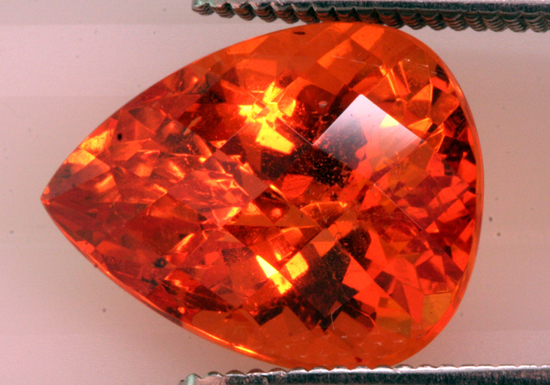
7.44 ct. Spessartine Garnet
Along with the beautiful oranges, darker Orange Reds and Reds such as this fine 7.42 ct. oval have been produced in both Namibia and Nigeria.
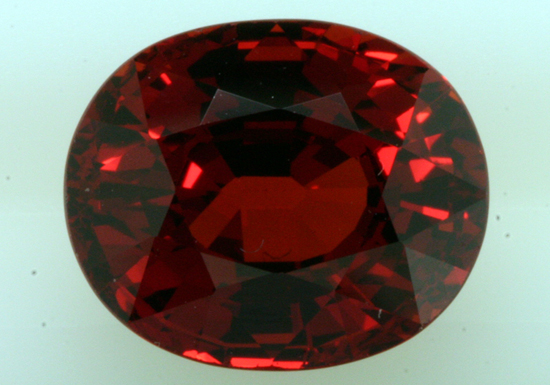
7.42 ct. Spessartine Garnet
Besides the wonderful colors, these African stones excite the gem world because of their relatively large size and great clarity. Other notable occurences of spessartine garnets, including the original find in the Spessart forest of Bavaria, the Amelia Courthouse stones of Viginia, and the bright orange gems from Ramona, California, have never produced significant quantities of large clean material like these African sources.
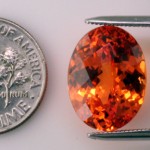
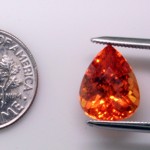
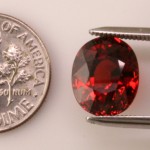
Colored stone deposits are the result of very specific geological conditions and are generally much smaller than diamond deposits. The current production of these beautiful African gems has dwindled as the market has readily absorbed these gorgeous stones– we have probably already seen the best of these gems. We expect we'll see new wonders this year, but who knows what– that's the exciting part! Stay tuned for our post show wrapup!
Tags: Amelia Courthouse, Fanta, Great Rift Valley, Kenya, Mandarin, Merelani, Namibia, Nigerian, Ramona, Spessart, spessartine garnet, Tanzanite, Tsavo, tsavorite







